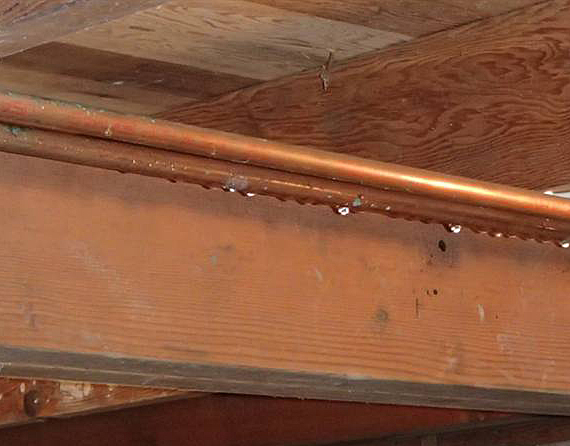
Insulating the hot waters pipes in your house is something of a no-brainer. Why let the heat escape willy-nilly? Pipe insulation is inexpensive, and the project is one that any homeowner could finish on a Saturday afternoon.
Whether to insulate the cold water pipes is less clear-cut. The project is still pretty inexpensive and easy — but does it have a point? Insulation retains heat, and these are cold water pipes. So why do it?
Protect pipes from freezing and limit condensation
There are a few good reasons. If the basement or crawl space has uninsulated walls (and really, you should insulate your basement walls), insulated cold water pipes would be less prone to freezing in cold climates.
If the basement is conditioned space, an insulated cold water pipe won’t absorb heat. If it is in a 1000% humidity climate like Georgia, cold pipes can be prone to condensation issues. A fully taped and insulated cold water pipe won’t condense moisture on its surface.
Should cold water pipes be insulated in cold climates?
My father grew up in houses where pipe freezing was a common occurrence. Since he slept in the basement bedroom of his childhood home, it’s not a surprise. That was one cold basement.
From USGS groundwater temperature data, we know that groundwater temperatures in Maine are generally below 50°F.
Many houses in Maine and similar heating climates have uninsulated copper and PEX pipes running through the basement ceiling joists. With winter temperatures routinely dipping below 0°F, it’s no surprise that cold water pipes can freeze.
Insulation is simply a material with above average resistance to thermal energy movement. The water comes out of the ground below 50°F into a winter environment that could be below 0°F. Wrapping those cold water pipes would keep what heat energy the water possessed in place, protecting against freezing.
Cold water pipes absorb heat
If the basement space is insulated, cold water pipes may absorb heat. The basement air temperature would be in the high 50s while the cold water pipes would be 10-12 degrees colder.
If the pipes were left uninsulated, this would be a continual, low-level draw of heat from the building. Normally this might be too small to bother, but the cost of insulating pipes is so minimal it becomes worth discussing.
Cold water pipes are a condensing surface for moisture in the air
Lastly, condensation concerns can be alleviated with pipe insulation. (Or rather, the possibility of condensation would be gone — you’re free to remain concerned.)
Basements and crawl spaces are embedded in damp soil, surrounding the permeable concrete with moisture. The spaces under houses often have elevated humidity levels and cold water pipes are a natural condensing surface. Stick any paper or valuables or valuable paper (perhaps your original run of Claremont X-Men issues) under a pipe elbow, and you’re in for a nasty surprise down the road.
The key for preventing condensation is to be sure that the pipe is insulated and that the insulation is sealed along the seams. Moisture-laden air must be kept from contacting the pipe surface. The pipe insulation should be a vapor-impermeable foam with all the seams and edges taped tight.
Insulating hot water pipes in a cold climate is a no-brainer. But there is a lot to be said for insulating cold water pipes as well.
Erik North, the owner of Free Energy Maine, is an energy auditor and home performance specialist in Westbrook, Maine. He is also the author of the Energy Auditing Blog.
Weekly Newsletter
Get building science and energy efficiency advice, plus special offers, in your inbox.





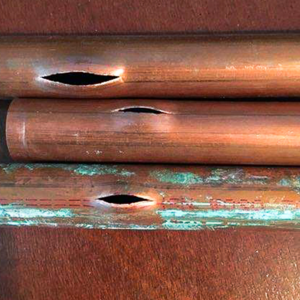
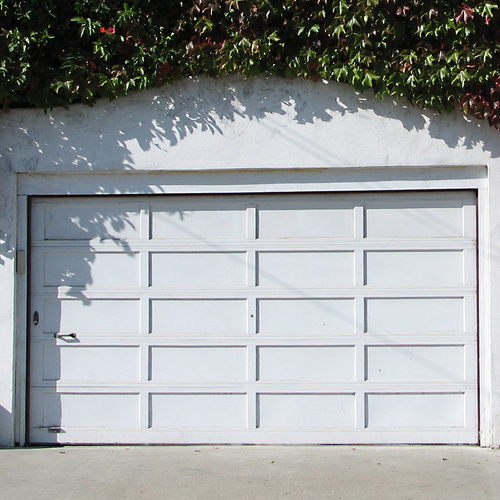
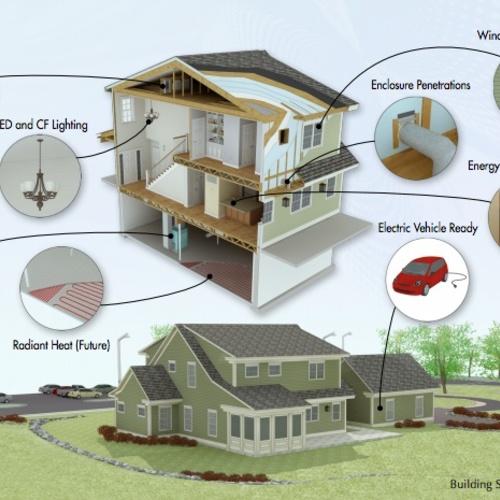
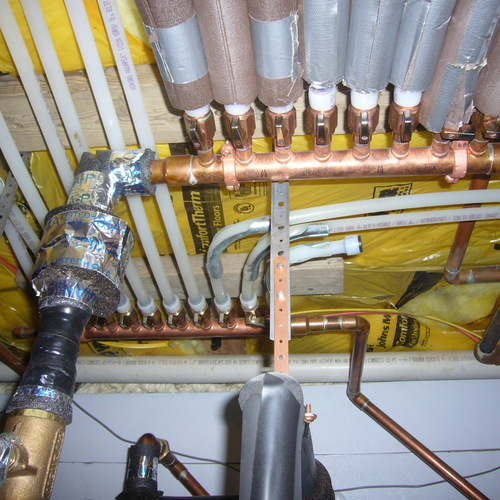






5 Comments
Insulate Cold Water Pipes THOUGHTFULLY
I had to do some repairs in a client's garage due to a bib supply pipe freezing in the ceiling. The plumber had conscientiously insulated it, 360 degrees, which cut it off from the marginal but significant heat source of the garage. The pipe froze in the ceiling but not in the exterior wall because the insulation was on the exterior side in the wall, allowing the garage to act as a heat source.
Response to Robert Fankhauser
Robert,
What was the source of heat in the garage? The water in the radiators of the parked cars, along with the warm iron of the engine?
If the air in the garage was cold enough to freeze the water in the pipes, as you describe, how would removing the pipe insulation have helped?
Ref Insulate Cold Water Pipes THOUGHTFULLY
The frozen pipe was in the attic of the garage. The drywall ceiling was insulated and the pipe was separately insulated even further, as I say, 360 degrees.
My experience is that garage roofs are almost always slightly warmer than main house attics- e.g., that's where the furnace and DHWH usually are. As I walk around my neighborhood on a cold morning, the frost melts from most garage roofs first and you can often see the effect of a little garage heat edging over into the main roof. So, I see garages as a source of heat. My assumption is that's what kept the part of the pipe in the wall from freezing as soon as the ceiling part.
A variation on the situation is one of my bathrooms, with 2 sets of pipes in the wall- toilet, near the heat register and sink, inside the vanity. Standard theory would say the sink line, somewhat insulated from the room, would freeze first. (Remember the "Leave your cupboard doors open in freezing weather." advice?) My experience is that only the toilet freezes & my theory is that the insulators and the plumber conspired to put the insulation on the room side of the toilet line & the exterior side of the vanity line. This happens overnight so heat from the HW side probably isn't a factor.
Obviously(?) my theory on why the pipe in the garage chose to freeze in the attic, but not the exterior wall is just a theory- as scientists we have to be willing to entertain competing theories. Got a different one?
Response to Robert Fankhauser
Robert,
I'm not sure of the circumstances that surrounded the garage in question -- and if I read your comments correctly, it sounds as if you aren't entirely sure, either.
I'll say this: in Vermont, we don't put cold water pipes in garage attics. For that matter, we don't put furnaces or water heaters in garage attics, either. So I'm not entirely familiar with these types of set-ups.
But it seems to me that you are overthinking the situation. Here's what happened: the air near the insulated cold water pipe was so cold that the water in the pipe froze. Under those circumstances, having an uninsulated pipe instead of an insulated pipe wouldn't have helped. After all, the air temperature was cold enough to freeze the pipe.
When the air gets that cold, stripping the insulation from your plumbing doesn't help.
Too much Thinking
Thanks for the topic.
I've insulated pipes over the past 30 years in 8 or so of my own houses and have struggled with any legitimate reason for doing so.
I've concluded that pipes (hot or cold) should be insulated simply because it's the right thing to do. I wouldn't go much beyond that statement or I believe you quickly get yourself into trouble. I market it as the hallmark of a conscientious person that shows he takes pride in his work. You tell people It may provide some level of additional convenience and a resource savings, but we all know it's really miniscule. If everyone every house in the country did it, then the community as a whole may see some benefit, but not the individual.
For cold water pipes, the only tangible advantage I can sign up to, is that they will simply not sweat in the summer. During the winter, any heat transfer would probably be more beneficial, so the insulation actually is a bit of a detriment. During the spring and fall, it just looks pretty.
For hot water pipes. I see it as incrementally increasing the level of convenience and saving a tiny amount of heating fuel. I'm dubious if the do it yourself guy ever recuperates the material costs.
The problem is the R value is too low and delta T too high. In my experience pipes cool off in about 15 minutes (for showering). I guesstimate one may save a few dozen gallons of hot water per year by insulating the pipes. Even if it's a hundred gallons, that's only 833 pounds of water times ninety degrees, which works out to less than a thousand BTU, or a few tablespoons of heating oil. I can't see how you'd ever save a gallon of oil per year by insulating hot water pipes.
We do it because it looks good. Like taking the time to fill nail holes and sweeping up when you're done, you do it because you should.
I don't believe insulating pipes with the insulation you're describing provides any real world protection from freezing. If pipes are in a potential freezing zone, then they need a constant heat source that's independent of the water source. To hedge your bets, the insulation needs to be as high as you can get it between the water and the heat sink (outside world) and as low as you can get it between the water and the heat source. A pipe wrap does this poorly.
Adding insulation can change the dynamics of a system in unexpected ways. Remember it's called thermodynamics for a reason. I own a 90 year house that was frozen pipe free for the first 75 years of its existence. I had the house insulated 15 years ago with blown in cellulose. The insulation company, by policy, did not insulate the bay where the hot and cold pipes ran up the exterior wall. Since I insulated, I had a problem with frozen pipes during extremely cold (for my climate) nights. Finally the cold water pipe burst a few years back, and I discovered it was improperly (and poorly) insulated with fiberglass in the cavity. I dense packed (by hand) fiberglass behind the patched pipe and haven't had a problem since. However this winter, thanks to the polar vortex, the hot water pipe burst. (It was about a foot away from the patched cold water pipe). Opening the wall revealed the same situation, and I repeated the same fix. Knock on wood, the pipes will survive till the next ice age.
Thanks again
Log in or create an account to post a comment.
Sign up Log in